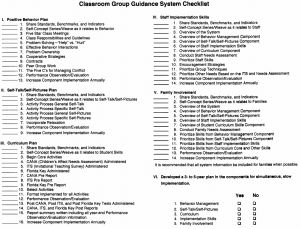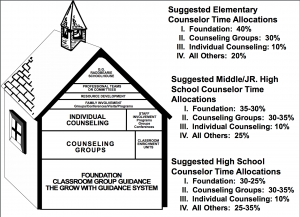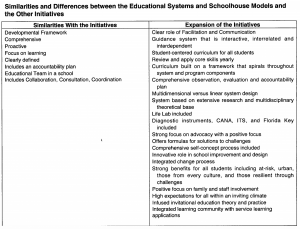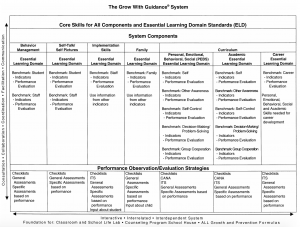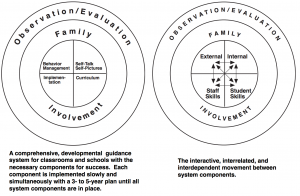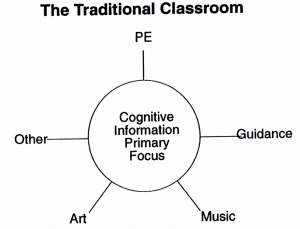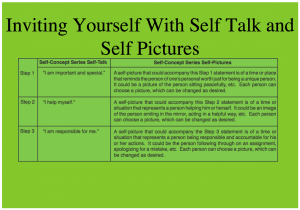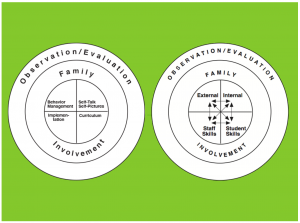What’s the School Counseling Program’s Role in Career Readiness
Learn the Answer for Success.
AOCC 2019 Conference
Columbus Convention Center, Hyatt Regency
November 8, 2019
If you have additional questions:
Dr. Tommie Radd, PhD. LPC. NCC. NCSC. CRC. Phone: 614-795-1373
Email: [email protected].
Web site: www.allsucceed.com
What’s the School Counseling Program’s Role in Career Readiness? [PDF] 2MB
In the life lab all students can learn to use their unique challenges as
assets. – Tommie R. Radd, PhD
What’s the School Counseling Program’s Role in Career Readiness?
Learn the Answer for Success.
Agenda
- Introduction
- The Overview of ASCA Standards, NCDA Crosswalk, Ohio State Social and Emotional Learning Standards and School Counseling
- An Overview of the Guidance System and System Components
- The Heart of the Real Classroom and Life Lab, Career Readiness Discussed
- The School-to-Career System Formula
- The Career Path Less Taken Ohio Public Television Documentary
- Participant Brainstorm 1 to 3 Ideas for Implementation of the School- to-Career Formula this year and future strategic planning
- Questions & Closing
Standards and Benchmark Reference Chart
National School Counseling, National Career Development, and Grow With Guidance
| Content Area | American School Counselor Association National Standards | National Career Development Guidelines | Grow With Guidnce® System |
| Academic Standards and Indicators |
|
ED1. Attain educational achievement and performance levels needed to reach your personal and career goals. ED2. Participate in ongoing , lifelong learning experiences to enhance your ability to function effectively in a diverse and changing economy. |
Students will: F.1. identify and express personal learning needs, F.2. gain appreciation of individual learning styles and abilities, F.3. assess abilities and skills, F.4. be aware of ways their academic performance is determined by their choices, F.5. demonstrate responsibility for the group and project outcomes, and F.6. demonstrate an understanding of attitudes and behavior necessary for successful work experience. |
| Career Standards and Indicators |
|
CM1. Create and manage a career plan that meets your career goals. CM2. Use a process of decision-making as one component of career development. CM3. Use accurate, current and unbiased career information during career planning and management. CM4. Master academic, occupational and general employability skills in order to obtain, create, maintain and/or advance your employment. CM5. Integrate changing employment trends, societal needs and economic conditions into your career plans. |
Students will: G.1. understand career/employment possibilities, G.2. know where and how to find additional information about careers/employment and G.3. describe the necessity and value of all types of careers/employment. |
| Personal/Social Standards and Indicators |
|
PS1. Develop understanding of self to build and maintain a positive self-concept. PS2. Develop positive interpersonal skills including respect for diversity. PS3. Integrate growth and change into your career development. PS4. Balance personal, leisure, community, learner, family and work roles. |
Students will: A.1. identify and express characteristics that are special and unique about themselves, A.2. define and describe feelings related to personal experience, A.3. describe conscious activites in relation to their personal feelings, A.4. identify personal needs and means to meet those needs, A.5. accept self and demonstrate a positive attitude toward self, A.6. demonstrate motivation towards all areas of growth, B.1. define and describe feelings in others related to specific experiences, B.2. recognize the needs of others and respond in a positive manner in awareness of others, B.3. appreciate the uniqueness and differences of people, B.4. demonstrate an awareness of the effects of their behavior on others, C.1. recognize and express limitations and needs, C.2. display behavior appropriate to the social setting, C.3. set and remain within behavioral limits and established values, D.1. identify and make choices from alternatives based upon awareness of consequences, D.2. demonstrate alternatives to use of drugs, alcohol, and tobacco – describe alternative ways of coping with stressful situations, D.3. demonstrate the power of peer pressure upon the choices a person makes – demonstrate appropriate refusal skills to pressures from peers, D.4. cultivate an awareness of personal, societal, and family values and their impact on the decision – making process, E.1. give and accept validating statements, E.2. demonstrate group support for a concern or problem, E.3. name behaviors which may help hinder group effort, and E.4. demonstrate effective listening skills. |
Similarities and Differences between the Educational Systems and Schoolhouse Models and the Other Initiatives
| Similarities With the Initiatives | Expansion of the Initiatives |
|
|

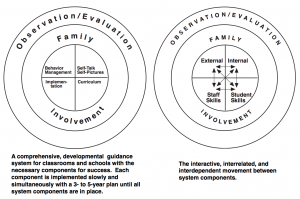
Invitational Education:
Theory of Practice based on Democratic Ethos Perceptual Tradition Self-Concept Theory The whole is equal to more than the sum of its parts. —Tommie R. Radd, PhD
Overview of a Guidance System
- Behavior Management – Extrinsic – what we say and do
- Self-Talk & Self-Pictures – Intrinsic – what we say and believe with what we think and feel
- Curriculum – Student Skills
- Implementation – Staff Skills
- Family Involvement – Family Skills
- Observation/Evaluation
System Components Implemented
- Congruent
- Systemic – identify all components of the System or whole and understand the relationship between components
- Slowly and simultaneously
- 3-5 year process
- The Whole is larger than the sum of the parts
The Self-Concept Series is taught to all students
- All are important and valuable no matter what they think, say, feel, and do.
- All show they are remembering their worth by making helpful choices toward themselves and others. They are responsible for helping not hurting self and others.
- All are responsible for their choices. This accountability empowers all to make improvements because of their worth.
NOTE: See Pod Cast at www.allsucceed.com
Life Lab
A way of defining the classroom as a simulation in which students, pre-K-12 and beyond, learn, experience, and apply the essential skills needed for life; the comprehensive developmental guidance system creates a life lab in every classroom through which students develop a conscious and intentional frame of reference that can be applied throughout life.

Invitational Education Formula
The Guidance System, Staff Involvement, Professional Teams or Committees
A Conscious and Intentional Plan with the skills and processes needed for a winning invitational education program.
A Life Lab of experiences needed for post-school success.
Students can develop their spirit, purpose, and potential when
- there is a plan for change that is an integral part of the day-to-day operation of a school
- there is a conscious plan to support the self-concept
development of all within a school - the perception of students, staff, and families
regarding school relationships, procedures, and
policies is communicated and modified when it is
destructive - personal, social, emotional, and behavioral skills are taught
- students provide ongoing feedback to educators as to their day-to-day experiences in school, and
- there is an intentional process for consciously creating an inviting environment for all students.
GWG Assessments Self-Concept Series Resources
- ITS
- CANA
- Florida Key
- Self-Concept Series
- ISS (see IAIE Web Site)
- Other System Assessment
Invitational Teaching Survey (ITS)
A 43-question diagnostic class climate assessment, taken by students, which gives student input about their classroom experiences and whether they have a feeling of being “invited”; a diagnostic tool to involve students and get their input on ways to improve climate and school relationships; one indicator of ways to support staff growth experiences and plans; one way to observe and evaluate change at the end of a school year through pre-post assessment; the school climate assessment included in The Grow With Guidance® System.
Children’s Affect Needs Assessment (CANA)
A 42-question diagnostic curriculum assessment taken by students that provides student input into their classroom guidance curriculum activity selection; a diagnostic tool to involve students and create a sense of student ownership for guidance skill implementation and change (Note: ownership occurs when students “own” a problem and admit, recognize, and acknowledge personal needs and challenges that support assuming responsibility and commitment for change); assessment questions asked in the five essential learning strands of the curriculum of The Grow With Guidance® System; one way to observe and evaluate change at the end of the school year through pre-post assessment; the student curriculum assessment included in The Grow With Guidance® System.
Your Action Plan
- List 3 ways you can implement the strategies for yourself! Starting with YOU helps you to feel more comfortable with helping others!
- Brainstorm 3 ways you can incorporate a plan for your school based on the System and Schoolhouse Information.
- Explain how the practices and strategies address creating a conscious and intentional inviting climate for you, your school community.
-
References
Radd, T. R. (2014). Teaching and Counseling for Today’s World: Pre-K-12 & Beyond Second Edition. Columbus, Ohio: Grow With Guidance. ISBN: 978-1-878317-58-2
Radd, T. R. (2014). Teaching and Counseling for Today’s World: Pre-K-12 & Beyond Second Edition, e-book. Columbus, Ohio: Grow With Guidance. ISBN: 978-1-878317-61-2
Radd, T. R. (2007). The Grow With Guidance System Manual Third Edition. Omaha, Nebraska: Grow With Guidance. ISBN: 978-1-878317-53-7 (1-878317-53-9).
Radd, T. R. (2014). The Grow With Guidance System Manual Third Edition, e-book. Columbus, Ohio: Grow With Guidance. ISBN: 978-1-878317-59-9
Radd, T. R. (2007). The Grow With Guidance Primary Level Third Edition. Omaha, Nebraska: Grow With Guidance. ISBN: 978-1-878317-54-4 (1-878317-54-7).
Radd, T. R. (2014). The Grow With Guidance Primary Level Third Edition, e-book. Columbus, Ohio: Grow With Guidance. ISBN: 978-1-878317-60-5
Radd, T. R. (2007). The Grow With Guidance Intermediate Level Third Edition. Omaha, Nebraska: Grow With Guidance. ISBN: 978-1-878317-55-1 (1-878317-55-5).
Radd, T. R. (2014). The Grow With Guidance System Intermediate Level Third Edition, e-book. Columbus, Ohio: Grow With Guidance. ISBN: 978-1-878317- 62-8
Radd, T. R. (2007). The Grow With Guidance Middle School Level Third Edition. Omaha, Nebraska: Grow With Guidance. ISBN: 978-1-878317-56-8 (1-878317-56-3).
Radd, T. R. (2014). The Grow With Guidance Middle School Level Third Edition, e-book. Columbus, Ohio: Grow With Guidance. ISBN: 978-1-878317-63-6
Radd, T. R. (2007). The Grow With Guidance High School Level Third Edition. Omaha, Nebraska: Grow With Guidance. ISBN: 978-1-878317-57-5 (1-878317-57-1)
Radd, T. R. (2014). The Grow With Guidance High School Level Third Edition, e-book. Columbus, Ohio: Grow With Guidance. ISBN: 978-1-878317-64-4 References
Radd, T. R. (2006). Classroom Activities for Teachers, Counselors, and Other Helping Professionals Pre-K–12 & Beyond Vol. I. Omaha, Nebraska: Grow With Guidance. ISBN: 1-878317-45-8
Radd, T. R. (2014). Classroom Activities for Teachers, Counselors, and Other Helping Professionals: Pre-K-12 & Beyond Vol I. Second Edition, e-book. Columbus, Ohio: Grow With Guidance. ISBN: 1-878317-65-2
Radd, T. R. (2006). Classroom Activiites for Teachers, Counselors, and Other Helping Professionals Pre-K–12 & Beyond Vol. II Omaha, Nebraska: Grow With Guidance. ISBN: 1-878317-46-6
Radd, T. R. (2014). Classroom Activities for Teachers, Counselors, and Other Helping Professionals: Pre-K-12 & Beyond Vol II Second Edition, e-book. Columbus, Ohio: Grow With Guidance. ISBN: 1-878317-65-
Radd, T. R. (2014). The Grow With Guidance System Music: G. G. Raddbearie Sings, e-book. Columbus, Ohio: Grow With Guidance. ISBN: 978-1-878317-68-7
Radd, T. R. (2007). The Grow With Guidance® System Music: G.G. Raddbearie Sings. Omaha, Nebraska: Grow With Guidance. isbn: 978-1-878317-47-6 (1-878317-47-4).
Radd, T. R. (2014). The Grow With Guidance System Fun Game Second Edition, e-book. Columbus, Ohio: Grow With Guidance. ISBN: 978-1-878317-67-9
Radd, T. R. (2007). The Grow With Guidance® System F.U.N. Game, Second Edition. Omaha, Nebraska: Grow With Guidance. ISBN: 978-1-878317-49-0 (1-878317-49-0)
Radd, T. R. (2006). The History, Development, and Research of the Educational Systems Model: The Grow With Guidance® System. Omaha, Nebraska: Grow With Guidance. isbn: 978-1-878317- 52-0 (1-878317-52-0).
A complete Research Report is available here.
